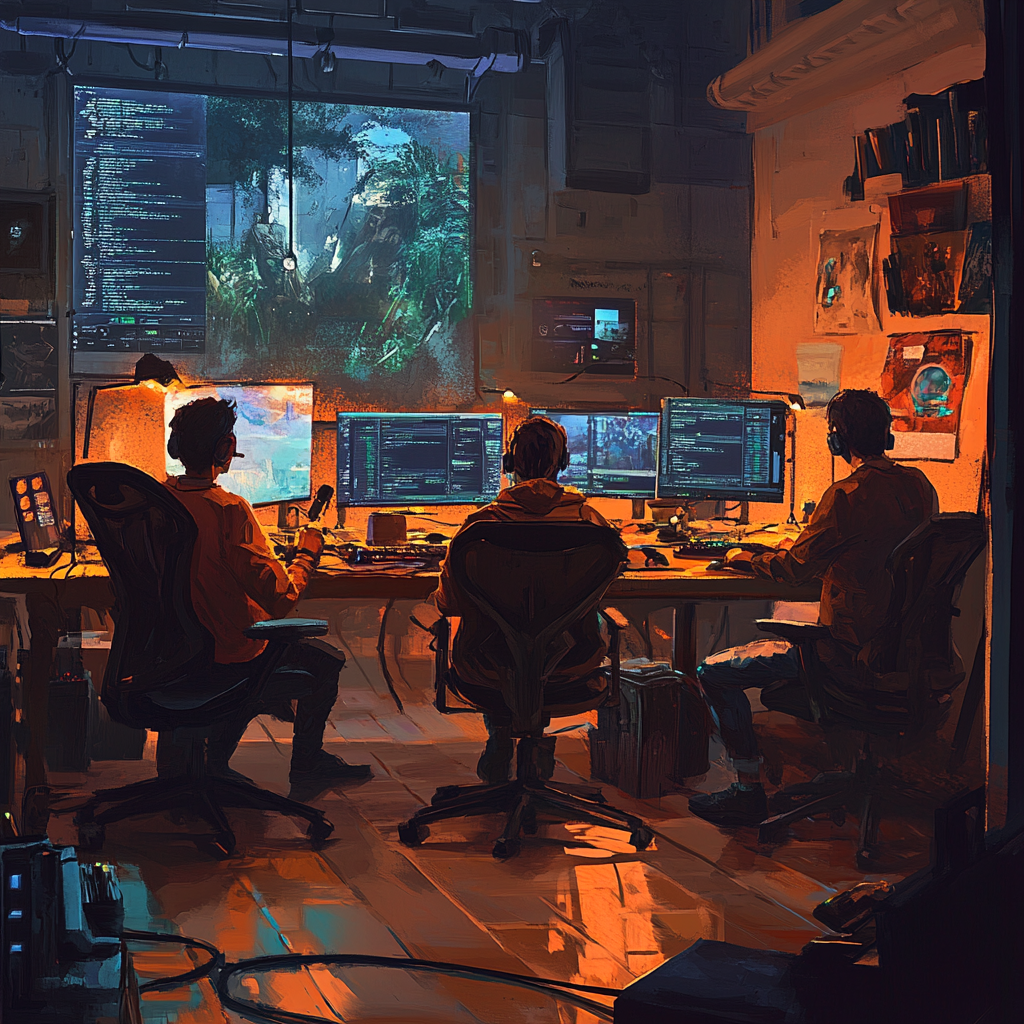The global gaming industry, valued at over $200 billion in 2024, is a realm of endless creativity and technical complexity. Yet, behind every successful game lies a critical foundation: a skilled and cohesive development team. So how to find a game development team that matches your expectations?
For studios and entrepreneurs, assembling the right team is not just about filling roles – it’s about finding collaborators who share your vision, technical prowess, and passion for innovation. This article explores actionable strategies to navigate the challenges of building a game development team, blending industry insights with practical advice to help you avoid common pitfalls and unlock your project’s potential.
By the end of this guide, you’ll understand how to align your hiring approach with your project’s scope, identify the right talent across global platforms, and foster collaboration in an industry where creativity and precision intersect!
How to find a game development team: understand your project’s DNA

Look: before launching a search for developers, defining your project’s scope is non-negotiable. Game development spans pre-production (concept design, budgeting, platform selection), production (coding, art, sound design), testing, and post-production (updates, bug fixes).
Each phase demands specific expertise. For instance, a mobile puzzle game may require fewer developers than an AAA RPG, but both need specialists in engines like Unity or Unreal, 2D/3D artists, and QA testers.
Budget and timeline further shape team composition. Indie projects often rely on freelancers or small studios, while larger ventures may blend in-house leads with outsourced talent. A hybrid model, for example, combines local project managers with offshore developers – a strategy that balances cost efficiency with creative control.
Navigating hiring models
Choosing the right hiring model is a pivotal decision in finding a game development team, as it directly impacts creativity, budget, and project scalability. Each approach – whether in-house, outsourced, remote, or hybrid – has distinct advantages and challenges.
Understanding these nuances ensures teams align with a project’s vision, timeline, and financial constraints while fostering innovation. So let’s talk more in depth about each approach: in-house teams, outsourcing and remote teams.

In-House Teams: Cohesion at a Cost
In-house teams are the backbone of studios prioritizing long-term creative control and iterative collaboration. By housing developers, artists, and designers under one roof, teams benefit from spontaneous brainstorming, shared technical workflows, and unified cultural values.
This model is particularly effective for AAA studios like Naughty Dog or Ubisoft, where multi-year projects demand deep narrative continuity and engine-specific expertise (e.g., The Last of Us Part II’s custom animation tools).
However, the financial burden of salaries, benefits, and office space can strain startups or indie budgets. For example, the average U.S. game developer earns 85,000–85,000–120,000 annually, making in-house hires unsustainable for smaller projects.
Studios must weigh these costs against the value of direct oversight – especially when prototyping experimental mechanics or refining proprietary technology.
Outsourcing: Leveraging Global Talent Pools

Simply put, outsourcing unlocks access to specialized skills without long-term commitments. Regions like Ukraine and Poland have emerged as hubs for AAA-quality work at competitive rates, with studios like CD Projekt Red (Warsaw) and Frogwares (Kyiv) contributing to franchises like The Witcher and Sherlock Holmes.
Platforms like Toptal and Upwork further democratize access to freelancers skilled in niche areas such as VR physics programming or stylized 3D modeling.
This model suits projects requiring scalability – such as seasonal content updates or asset-heavy open worlds. For instance, Hogwarts Legacy outsourced environmental art to external studios to meet its sprawling map demands.
Yet, outsourcing risks miscommunication if expectations aren’t meticulously outlined. Tools like Trello for task tracking and Figma for real-time design reviews mitigate this by fostering transparency between core teams and contractors.
Remote Teams: Flexibility with Structured Frameworks
The rise of remote work has reshaped game development, enabling indie creators to collaborate globally. Platforms like Develteam and GameDev.net connect developers across time zones, while tools like Slack and Miro replicate in-office synergy.
Remote models excel for narrative-driven indie games, where diverse perspectives enrich storytelling – evident in Disco Elysium’s internationally distributed team.
However, asynchronous communication can delay problem-solving. Successful remote teams adopt agile methodologies, scheduling overlapping hours for critical meetings and using GitHub for version control.
Regular check-ins and virtual “co-working” sessions via Zoom also build rapport, ensuring artists and programmers stay aligned on milestones.
Hybrid Models: Balancing Control and Agility
Hybrid models blend the stability of in-house leadership with the flexibility of external talent. For example, a studio might retain core designers and engineers to oversee gameplay loops while outsourcing QA testing or voice acting.
This approach proved vital for Hades (Supergiant Games), where a small internal team managed narrative design while collaborating with freelancers for music and localization.

Hybrid structures also accommodate fluctuating workloads. Post-launch updates or DLCs often require rapid scaling – something agencies like Pingle Studio specialize in by offering on-demand developers.
By maintaining a core team, studios preserve institutional knowledge while avoiding the overhead of full-time hires during quieter phases.
Finding a game development team for your chosen model
No single model fits all projects. Indie developers might prioritize cost-effective remote collaborations, while AAA studios invest in in-house R&D. Budget, timeline, and creative scope should guide decisions.
For deeper insights into optimizing team dynamics, explore our article on agile development, or consider partnering with studios like us that offer hybrid solutions, ensuring your game’s vision remains uncompromised from concept to launch.
By strategically blending hiring models, developers unlock the best of both worlds: the precision of dedicated teams and the adaptability of global talent. The key lies in clear communication, rigorous planning, and a willingness to evolve as the project – and industry – advances.
Sourcing talent: where to look for a game development team
The digital age offers myriad avenues to find game developers, such as:
- Main Leaf: Well, of course! We specialize in helping peaople navigate the complexities of game development. We’re not just another player in the industry: we’re the game changers! With over 70 experts covering all specialties of game development, we’re here to bring your gaming dreams to life with our solutions perfectly tailored to your needs. Whether you’re just stepping into this world or need last-minute outsourcing solutions for your project, we’ve got you covered with our experience spanning over a decade – so make sure to contact us by the end of the article!
- Freelance Platforms: Upwork and Toptal host profiles of programmers, artists, and sound designers. While cost-effective, vetting candidates for reliability is crucial .
- Game Dev Communities: Platforms like GameDevFinder and TIGSource cater to indie creators, offering search filters for roles like 3D animators or narrative designers. These communities emphasize collaboration over transactional hires, fostering long-term partnerships .
- Outsourcing Agencies: Firms like Qubit Labs or Pingle Studio streamline recruitment, providing pre-vetted teams with portfolios in AAA titles or niche genres. This approach minimizes hiring risks and accelerates project kickoffs.
As for how to evaluate your candidates, technical proficiency in engines (Unity, Unreal) and languages (C#, C++) is a baseline. However, successful teams thrive on soft skills:
- Portfolio Depth: Review past projects for stylistic range and technical complexity. A developer’s ability to adapt to your game’s aesthetic (e.g., pixel art vs. hyperrealism) signals versatility.
- Collaboration Fit: Gauge communication styles during trial tasks. Tools like GitHub or Figma reveal how candidates document work and iterate on feedback.
- Cultural Alignment: Time-zone overlap, language fluency, and shared creative vision prevent misalignment. For remote teams, regular sync-ups via Zoom or Discord build rapport.
Read also: Learn how to develop web games in 2025!

Build your legacy with Main Leaf!
Finding a game development team is a journey of strategic choices – balancing creativity, budget, and collaboration. Whether you’re an indie creator or a studio head, the key lies in clarity of vision, rigorous vetting, and fostering a culture of mutual respect.
For those seeking a partner to navigate this complex landscape, we here at Main Leaf offer end-to-end development services, from concept art to post-launch support. Explore our blog for deeper insights into game engines or team dynamics, or contact us to discuss how we can bring your vision to life.
In an industry where innovation never sleeps, the right team isn’t just a resource – it’s your greatest ally.

